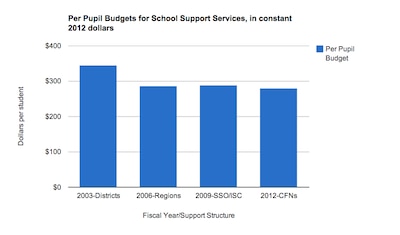The city has cut spending on school bureaucracy over the past decade, a budget watchdog says.
According to a new report from the Independent Budget Office, the city spent about 22 percent less to provide schools with teacher training, budget planning, staff recruitment, and other administrative services in 2011-12 than it did in the 2002-03 year, after adjusting for inflation.
The cost savings came as the city shifted and consolidated its bureaucracy under Mayor Michael Bloomberg. Prior to 2003, support was primarily provided to schools through 38 community and high school superintendents who each governed their own local district. By 2009, the city had settled on a new “network” structure largely divorced from geography.
Schools rely on support structures for crucial functions, like helping them select technology and curriculum vendors and to improve instruction, and the networks were the topic of much debate among principals at the end of Bloomberg’s tenure. Total spending on school support in 2011-12 reached $293.1 million.
But the current system may not remain in place for long.
“Change may be coming again,” the report’s authors write, alluding to Mayor Bill de Blasio’s pledge to restore some authority to district superintendents. De Blasio has criticized the current system as being unresponsive to parent concerns.
If the de Blasio administration changes the structure for school support, he’ll be following in Bloomberg’s footsteps. The previous mayor oversaw three such shake-ups between 2003 and 2009.
Bloomberg’s first big change came in 2003 when he consolidated power from 38 superintendents to 10 regional superintendents. One of the new administrators was Chancellor Carmen Fariña, who has spoken positively of that structure since taking over the Department of Education.
That 2003 overhaul resulted in a $72 million inflation-adjusted spending decline, according to the report, the biggest spending drop to result from the three reorganizations.

Since 2009, principals have received support by partnering with one of more than 60 Department of Education or nonprofit-run providers, regardless of geography. The “network” system emerged as one way to offer principals greater authority, but has also been criticized for separating schools from their communities and allowing some networks to be less responsive to their schools.
Those networks have remained intact eight months into the de Blasio administration. In April, Fariña told principals that the current system would remain in place “with minimal interruption” for the time being.
Ray Domanico, the IBO’s director of education research, said the potential for changes in the near future and an increasingly cryptic budgeting system made it a good time to note the implications of the restructuring under Bloomberg. School-support spending is increasingly spread out across various parts of the Department of Education’s budget, a trend that Domanico said makes it harder for the public to know how their tax dollars are being spent.
“Just in terms of transparency it’s significant,” Domanico said.
